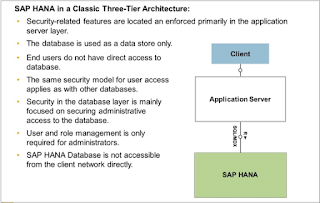Why and when, we require HANA database security management?
The following main SAP HANA Security
Perspective scenarios are possible:
● SAP HANA as a data mart
for reporting and analytics
● SAP HANA in a classic
three-tier architecture as the primary database. For example, in
SAP BW/4HANA or SAP S/4HANA
installations.
● SAP HANA as a platform for
providing database and application services to native SAP
HANA based applications
Note:
data marts à
With SAP HANA, operational data marts offer real-time analytics and reporting on data replicated
from a transactional system's database. The raw tables themselves are copied
(structure and data) from the transactional system's database into SAP
HANA.
In a data mart scenario,
data is replicated from a source system (ECC, No-SAP Database etc.) into the
SAP HANA database. Reporting is then carried out on the data in SAP HANA (for
Example, using read-only
views, dashboards, and so on). Some end users usually have direct access to SAP
HANA. Therefore, user and role management in SAP HANA is required for these end-users, as well as for technical users and administrators.
SAP HANA in a Classic Three-Tier Architecture
You can use SAP HANA as a
relational database in a classic three-tier architecture (client,
application server, and
database). Security-related features are located and are enforced in
the application server
layer. These security features include authentication, authorization,
encryption, and auditing. The database is used as a data
store only.
The classic three-tier architecture has the following
features:
The same security model for
user access applies as for other databases.
End users do not have direct access to either
the database itself or the database server on
which it is running.
Security in the database layer is mainly
focused on securing administrative access to the
database.
Specific SAP HANA security features are needed
to control access of administrators to the database.
SAP HANA as a Platform
SAP HANA includes SAP HANA
extended application services. SAP HANA extended
application services embed
a full-featured application server, Web server, and development
the environment within SAP HANA.
Applications can be deployed directly on SAP HANA extended application services. It
exposes these applications to end users through a web interface.



